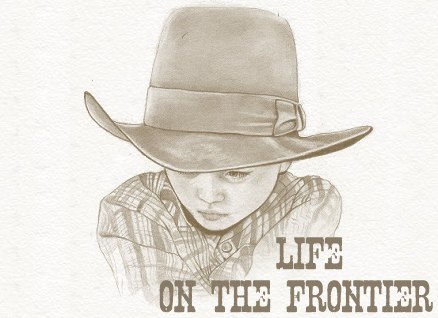THE WAGON: Known
as prairie schooners, the wagons of the 1860's were generally ten feet long, four feet
wide, and two feet deep; some of them had false bottoms in which items could be stored.
The canvas top--double thick and waterproofed with paint or linseed oil--was stretched
over bows that were high enough that a person could stand in the center. Sometimes
storage pockets were sewn on the inside of the canvas to hold toilet articles, favorite
books, and kitchen cutlery.
COOKING: Usually the food was placed in a kettle suspended over the campfire by
means of a pole laid across two forked sticks. Accidents and burned food were
common. For those who had brought along a milk cow, there was always fresh milk for the
children. After the evenings milking the remaining milk was usually placed in
covered pails under the wagon, and in the morning the cream would be skimmed off and put
into the tightly lidded churn to be turned into butter and buttermilk by the jolting of
the wagon.
WASHING: Washing wet and muddy bedding and clothing
was no easy task. Keeping babies in clean diapers posed special problems, where water was
scarce mothers often resorted to the practice of drying, scraping, and airing the diapers
and reusing them without washing them at all until water was available and they could be
boiled in a pot over a campfire.
ILLNESSES: Outbreaks of typhoid, whooping cough,
smallpox, and chickenpox were also prevalent, and any of the diseases could prove to be
deadly, given the wrong set of circumstances. Wet bedding, freezing winds, and rapid
changes in temperature often resulted in colds which sometimes turned into pneumonia or
"lung fever". Cholera was the most deadly contagious disease to strike the trains. Partly because of the speed with which it spread and partly because of the poor sanitary practices of the travelers, cholera killed hundreds, some say thousands, of emigrants.
CLOTHING: Men wore heavy boots, stout trousers, woolen shirts,
waterproof jackets and coats, strong leather gloves and broad-rimmed hats, Hooped skirts
were particularly difficult to manage. Most of those women who began the journey in
hoops soon abandoned them, though without the hoops, their dresses dragged the ground,
getting muddy or soaked with dew and often catching on twigs or briars. Other women forsook high fashion in favor of practicality, opting for cotton or linsey-woolsey dresses, ample aprons, and sunbonnets. But since any long-skirted garment, whether high-fashion or low, could be ignited by a campfire or caught under the wheels of a passing wagon, westering women clearly needed other options for day-to-day wear. In 1851, Amelia Bloomer's invention of a combination skirt and trouser outfit provided that option. Settlers children also often wore clothing made from materials readily available. Worn or outgrown clothes were taken apart and stitched into "new" garments. Mothers often took apart their own clothes to refashion them into children's attire. Girls on rural homesteads wore plain and colorless, long-sleeved high- necked dresses of linsey-wooley or gingham over their pantalettes and petticoats--and always a sunbonnet. Boys wore heavy boots and long pants and kept
their shirts on, no matter how hot the sun.
SHELTER: With timber hard to find, the settlers in the Great American Desert--and
central and northern plains--often built soddies of two and a half foot long blocks cut
from strips of previously untouched turf that were turned up and cut by a sod-breaking
plow. Soddies, while not the most elegant of homes, provided more protection
from the elements than did the tar paper homesteader shacks used by emigrants to later
frontiers. Tar paper shacks constructed in the early part of the twentieth century, was
the family's easiest means of meeting the government's demand the homesteaders live on the
claims in dwellings at least ten feet by twelve feet in size. Economy not
comfort was the primary concern of most of the settlers who tried their luck on this
desolate frontier, and when drought drove all but the hardiest back to where ever they'd
come from, the shacks they left behind represented no great loss.
CHILDRENS CHORES: The tasks that fell to children were endless---and essential.
Until a homestead had a well, water had to be hauled from the nearest source---a spring or
creek. Children quickly learned it was easier to carry two buckets of water, one in
each had than to struggle along, unbalanced, with only one. On washdays children stood for long hours using a stick to poke down the clothes in the wash pot of boiling water. They were often the ones charged with such tasks as emptying the slop jars each morning, collecting fuel for cooking and heating, chopping and stacking firewood, and trimming the wicks of kerosene lamps. Other chores that fell to children, were helping in the fields, gathering eggs, milking the cow, churning of butter and numerous other chores.
EDUCATION: A settlement's first school was usually a one-room building made of logs or sod and furnished with hard wooden benches, a cast iron stove, and a large bell that summoned the pupils to class. For drinking water, there was a bucket and dipper; for recreation, an open field; for rest rooms, an outhouse. The earliest schools were usually quot;subscription schools" organized by the parents who drew up a program, hired a teacher, and charged families an agreed upon amount of tuition for each child. The system of "public education" came only belatedly to frontier communities and states. Students came to school on foot, on horseback, and in wagons, carrying their slates and tablets. Because of the severity of the winters, school terms in the plains states usually ended in December, with classes reconvening in late spring. Frontier teachers and parents had a tacit understanding the students would attend school only when the weather permitted.



